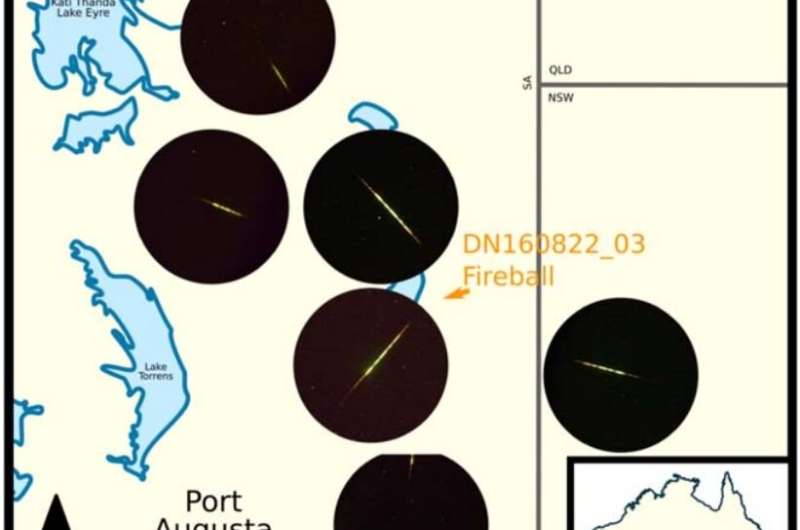Map of camera observations for event DN160822_03 in Southern Australia by the DFN. The orange arrow indicates the ground track of the fireball’s luminous trajectory. This path is extremely small due to the nearly vertical slope of the trajectory (≈86°.6). Six camera observations were collected during the 5.32 s duration. Credit: The Astronomical Journal (2019). DOI: 10.3847/1538-3881/ab3f2d
A team of researchers at Curtin University studying data from Australia's Desert Fireball Network has identified a minimoon fireball. In their paper published in The Astronomical Journal, the group describes how they found the fireball and the methods they used to show that it had come from a minimoon.
As the researchers note, space objects that make their way close to Earth but do not immediately get pulled in by gravity are known as temporarily captured orbiters (TCOs), natural Earth satellites, or simply minimoons. Such objects circle the planet rather than plunge through the atmosphere and into the ground—at least for a time. It is believed most such objects do not circle the Earth for very long—they eventually succumb to gravity and crash through the atmosphere, or are instead flung back into space. As the researchers also note, to date only one such object has ever been recorded circling the Earth—an object named 2006 RH120 was spotted back in 2006 circling the planet—it did so for approximately 11 months before it escaped the Earth's gravity and made its way back into space. Also, only one minimoon fireball has ever been observed—a team running a camera network in Europe spotted one back in 2014. In this new effort, the researchers report a second identification of a TCO blazing through the sky as a fireball prior to hitting the ground.
The researchers found evidence of the fireball by poring through data from Australia's Desert Fireball Network—a system of cameras (that also captures flight path) set up across the country for the specific purpose of capturing photographic evidence of a minimoon fireball. To find evidence of such a fireball, the researchers studied the photographs looking for evidence of any type of fireball, be it from a meteor or a TCO. Once found, the team used the flight path data to calculate the trajectory of the blazing object—objects circling the Earth before streaking through the atmosphere will have come in at a smaller angle.
The researchers suggest it is likely more such objects will be found in the coming years as more interest in them mounts—they represent an opportunity to capture a space object in its native state.
More information: P. M. Shober et al. Identification of a Minimoon Fireball, The Astronomical Journal (2019). DOI: 10.3847/1538-3881/ab3f2d
Journal information: Astronomical Journal
© 2019 Science X Network























